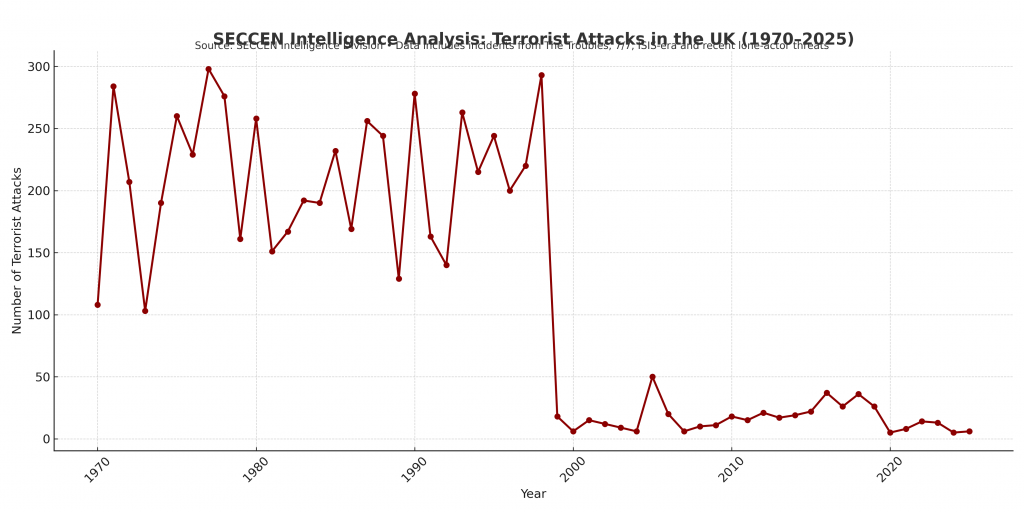Total Recorded Incidents and Fatalities
| Period | Number of Incidents | Fatalities | Injuries |
|---|
| 1970–2000 | 5,218 | 3,447 | 5,937 |
| 2001–2025 | 1,000+ | ~100 | 1,000+ |
Note: The majority of fatalities between 1970 and 2000 were attributed to the Northern Ireland conflict.(Wikipedia)
🕰️ Peak Periods of Terrorist Activity
1970s–1990s: The Troubles
- The conflict in Northern Ireland, known as “The Troubles,” was the predominant source of terrorist activity during this period.
- Key organisations involved included the Provisional Irish Republican Army (PIRA), Ulster Volunteer Force (UVF), and Ulster Defence Association (UDA).
- Notable incidents:
- 1974 Birmingham pub bombings (21 fatalities).
- 1998 Omagh bombing (29 fatalities), attributed to the Real IRA.(Wikipedia)
2000s–2010s: Rise of Islamist Extremism
- The early 2000s saw a shift towards threats from Islamist extremist groups.
- Significant incidents:
- 2005 London bombings (7/7): Four coordinated suicide bombings resulting in 52 deaths and over 700 injuries.
- 2017 Manchester Arena bombing: Suicide attack during a concert, causing 22 deaths and over 800 injuries.
- 2017 London Bridge attack: Vehicle and knife attack leading to 8 deaths and 48 injuries.(AP News)
2020s: Emergence of Diverse Threats
- Increase in threats from extreme right-wing groups and individuals with mixed or unclear ideologies.
- Notable incidents:
- 2021 Murder of MP Sir David Amess by an individual with Islamist motivations.
- 2023 Southport stabbings by Axel Rudakubana, highlighting challenges in identifying ideological motives.(Financial Times)
🏴☠️ Proscribed Terrorist Organisations
As of June 2025, the UK has proscribed 81 international terrorist groups under the Terrorism Act 2000 and 14 organisations in Northern Ireland under previous legislation. (Research Briefings)
Notable Organisations:
- Islamist Extremist Groups: Al-Qaeda, Islamic State (IS), Hamas.
- Irish Republican Groups: Provisional IRA, Continuity IRA, Real IRA.
- Far-Right Groups: National Action, The Base, Atomwaffen Division.(Wikipedia)
📈 Evolution of the Terrorist Threat Landscape (2005–2025)
Post-7/7 Developments
- The 7 July 2005 London bombings marked a significant shift in the UK’s counter-terrorism approach, leading to the implementation of the CONTEST strategy.
- Focus expanded to include not only Islamist threats but also emerging dangers from other ideologies.(Wikipedia)
Rise of Lone-Actor and Mixed-Ideology Threats
- Increase in self-radicalised individuals acting independently, often influenced by online propaganda.
- Growth in cases involving individuals with mixed, unstable, or unclear ideologies, posing challenges for traditional counter-terrorism strategies.(The Guardian, Wikipedia)
Current Threat Assessment
- MI5 indicates that Islamist extremism accounts for approximately 75% of its caseload.
- Extreme right-wing terrorism constitutes about 10% of investigations.
- The remaining cases involve other forms of extremism or individuals without a clear ideological affiliation. (ISD, MI5)
🔍 Current Threats and Challenges
Islamist Extremism
- Continues to be the predominant threat, with concerns over returning foreign fighters and online radicalisation.
Extreme Right-Wing Terrorism
- Notable increase in activities and plots, often facilitated through online platforms.
State-Sponsored Threats
- Emerging concerns over espionage and influence operations from hostile states such as Russia and Iran. (The Guardian)
Youth Radicalisation
- Growing number of young individuals being targeted for radicalisation, necessitating enhanced preventive measures.

A sustained high volume of attacks during The Troubles (1970s–1990s).
A sharp drop in the early 2000s.
Spikes in 2005 (7/7 bombings) and again during 2016–2019 due to ISIS-inspired activity.
Lower but consistent levels of attacks in the 2020s, reflecting the rise of lone actors and ideological diversity.
🧠 Conclusion
Over the past five decades, the UK’s terrorist threat landscape has evolved from region-specific conflicts to a complex array of domestic and international threats. The shift towards self-radicalised individuals and the diversification of extremist ideologies present ongoing challenges for security services. Continuous adaptation and comprehensive strategies are essential to address the multifaceted nature of modern terrorism.
Note: This report is based on publicly available information up to July 2025. For the most current threat assessments and guidelines, please refer to official sources such as MI5 and the Home Office.